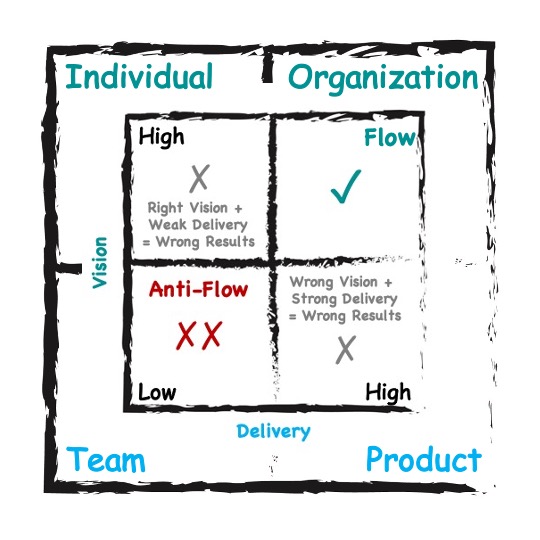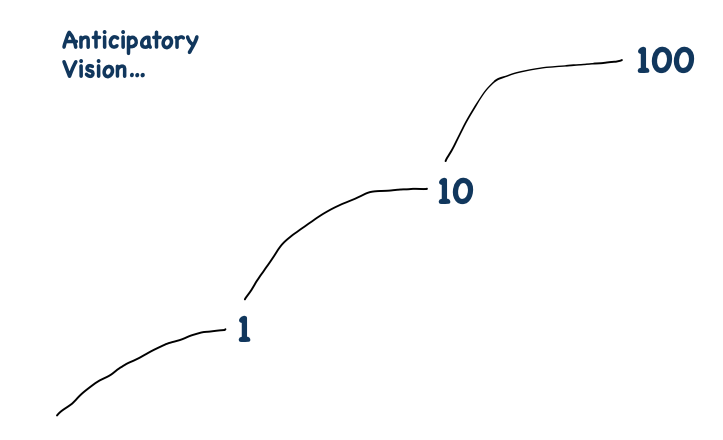Is your organization’s clarity of Vision high or low?
Is your ability to Deliver on that vision high or low?
Nokia is a cautionary tale of an organization that devolved into anti-Flow.
What’s truly amazing about the Nokia saga is that the same Board that made the bold decision to leap from producing rubber tires and boots to becoming a global tech giant was the same Board that failed to anticipate the future facts.
The needed creative destruction failed to happen the second time around. They completely missed the boat with the production-ready, touch-screen phone that their teams had prototyped already in 2004, years ahead of the launch of Apple’s iPhone.

The rest is history.
Sometimes inspiration comes from above. Sometimes from afar. Sometimes both. Thanks, Claudio M Lisondo, for reminding me of the Nokia case. Perfect example of anti-Flow!

As Paul Harvey used to say, “…and now for the rest of the story…” check out today’s blog post and the short YouTube video I’ve shared on this topic (link at the end of this post).
There’s another part of the Nokia story that I share in the Flow Certified Professional online training. I worked for Nokia (2005), NSN (2006) and Fruugo (2007). Fruugo was an online retail experiment carried out by a number of investors, including at least three from the Nokia Board at that time.
Since I was an American, the executives and one of the Marketing guys for Nokia wanted to hear what I thought about the launch of the Apple iPhone. In a flash of foresight and anticipatory vision, I walked up to the white board and drew the following picture:

They asked, “what’s that?!”
They were a little taken aback when I told them that “the “1” was the one million handsets that Apple would sell with the first version of the iPhone. The “10” was 10 million handsets in sales for the iPhone II. And the “100” was 100 million handsets in sales for the iPhone III. And, that after Apple hit 100 million in sales, that Nokia was dead.”
They laughed.
They even mocked me.
The one executive said, “oh Andrew, we produce 462 million handsets a year. We control the European, African, the Middle Eastern and Asian markets. We don’t give a sh– what the guys in Silicon Valley are doing…“
He even went further and derided the fact that “the iPhone doesn’t even have an alarm clock.” He didn’t understand the ecosystem that Apple was building where an army of developers would create Apps and games in the hope of making it big. Apple’s ecosystem now generates more revenue than Nokia’s sales back in 2007. Incredibly short-sighted on Nokia’s part.
My response was, “well, obviously you have info and intel that I don’t have … and that’s why you get the big bucks.”
A couple of years later the Marketing guy sends me an email after the launch of the Apple iPhone II and said, “Andrew, you were right!” My response back to him was, “It didn’t matter, no one listened.” He asked if he could send my response to the executive that mocked me. I said yes.
Nokia’s Board had gotten fat, dumb and happy as we say in American English. Pride goes before the fall … and, what a spectacular fall it was! They had focused on Operational Excellence at the expense of Anticipatory Vision and Innovation (even though they held the future in their hands long before anyone else).
Worse, they ignored incredibly valuable feedback that could have changed the course of Nokia’s sad history. Or, at minimum, given Nokia a few extra years of life? Hard to say since we’re only speculating at this point. It would have been a spectacular marketing battle if Nokia had the guts to put “mobile phones with glass screens in the pockets of their customers…” They felt that was too risky. Bad call.
Want to learn more about the Flow Leadership Framework? Let’s chat!
PS Here are the associated links to this blog post for:
#culture #scrum #agile #pmi #pmp #kanban #lean #flow #scaledagile #transformation #change #transform